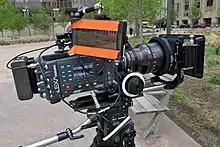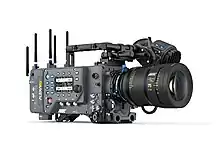
The Arri Alexa is a digital motion picture camera system developed by Arri. Introduced in April 2010, the camera was Arri's first major transition into digital cinematography, after previous product efforts including the Arriflex D-20 and D-21.
Alexa cameras are designed for use in feature films, television shows, and commercials. Alexa uses the ALEV series of image sensors manufactured by ON Semiconductor.[1]
Overview

The Alexa camera system introduced their Log-C imaging science as a digital negative to make digital cinema images process like scanned film images.
The camera has several methods of recording, including SxS cards, CFast 2.0 cards and SXR Capture Drives at resolutions up to 3424 × 2202 pixels in either Rec. 709 HD Video color space or Log-C to ProRes or ARRIRAW codecs. The Alexa camera offers additional optional software licenses that unlock different capabilities of the Alexa Camera including High Speed 120fps recording, DNxHD codec and 4:3 "Open Gate" Mode for anamorphic lenses.
The Alexa camera system includes modularity, PL mount lenses, a Super 35 sized CMOS sensor shooting up to 3424×2202 resolution and supports uncompressed video or proprietary raw (ARRIRAW) codec.[2]
The price of the camera depends on model and accessories; as an example in 2015 an Arri Alexa XT cost approximately $66,000-100,000, depending on accessories included.[3]
Model range
The range of Alexa models has expanded over time:
Alexa
The Alexa, announced in April 2010, was the first camera released of the product family. The Alexa's CMOS Super-35mm sensor is rated at 2.8K and ISO 800. That sensitivity allows the camera to see a full seven stops of over exposure and another seven stops of underexposure. To take advantage of this, ARRI offers both industry-standard REC709 HD video output as well as the Log-C mode that shows the entire range of the chip's sensitivity, allowing for an extreme range of color correction options in post.
Alexa Plus (4:3)
The Alexa Plus added integrated wireless remote control, the ARRI Lens Data System (LDS), additional outputs, lens synchronization for 3D, and built-in position and motion sensors and a 4:3 sensor making it ideal for anamorphic cinematography.
Alexa M
The Alexa M had its imaging and processing unit broken down in two parts to be small, compact and lightweight for 3D rigs and other uses where size is a concern. A special version of the Alexa M, called the Alexa SXT-M, was created for Gemini Man.
Alexa Studio
The Alexa Studio features an optical viewfinder, mechanical shutter, and a 4:3 sensor for anamorphic cinematography.
Alexa XT
In February 2013,[4] the range was renewed as Alexa XT (XT standing for extended technology). This range is upgraded versions of the original Alexa cameras, which are equipped with a so-called XR module, which replaces the SxS module on the cameras, and allows direct raw recording without the need for an external recorder. This module records on dedicated SSDs. Further improvements are an internal ND filter unit, a 4:3 sensor, an Open Gate sensor mode, and a quieter cooling fan. The range accordingly comprises the Alexa, the Alexa XT, the Alexa XT M, the Alexa XT Plus, the Alexa XT Studio, and the Alexa Fiber Remote. Existing cameras can be upgraded with the XR module for internal raw recording.[5]
Alexa 65
On 21 September 2014 at the Cinec convention in Munich, Arri announced the Alexa 65,[6] a 6K 65mm digital cinema camera. As with cameras from competitor Panavision, the Alexa 65 camera was available by rental only, provided through the ARRI Rental Group.[7] The Alexa 65 uses the A3X sensor, composed of three vertical ALEV III sensors, which has a maximum recordable resolution of 6560x3100.[8][9]
The first production to use the camera was Mission: Impossible – Rogue Nation (2015), which was used to shoot the underwater sequence, and around forty percent of The Revenant.[10]
A custom 3D variant was used to film specific scenes in Captain America: Civil War (2016). Avengers: Infinity War (2018) and Avengers: Endgame (2019) the first narrative feature films shot entirely with the camera.[11]
Alexa Mini
On 24 February 2015, Arri announced the Alexa Mini. It has the same sensor as the other Alexa cameras. It features in-camera recording to CFast 2.0 cards, 200 FPS and 4K UHD in-camera upscaling.
Alexa SXT
On 18 March 2015, Arri announced the SXT line of Arri Alexa cameras which will support in-camera upscaling of Apple ProRes to 4K resolution and Rec. 2020 color space.[12][13] Arri also announced the SXR module which can upgrade XT, XT Plus, and XT Studio cameras with the SXT features.[12][13]
Alexa LF

On 2 February 2018, Arri announced the Alexa LF at the BSC Expo. It is a 4K Large Format Camera. The Alexa LF's A2X sensor is based on two vertical ALEV III sensors, which are stitched together to create a seamless large format image. This is the same principle that was used to create the Alexa 65, which uses three Alexa sensors that are arranged vertically. The Alexa LF can record in Open Gate in a resolution of 4448 × 3096.[14][15]
Alexa Mini LF
On 28 March 2019, Arri announced the Alexa Mini LF, which houses the same sensor as the Alexa LF inside a camera body similar to the Alexa Mini. Additional improvements over the Alexa Mini include an improved EVF (MVF-2) with larger flip-out monitor and power outputs for camera accessories. The camera also features a new Codex recording module, which accepts 1TB Codex Compact Drives.[16] It was ARRI's top-selling camera prior to the COVID-19 pandemic.
Alexa 35
On May 31, 2022, Arri announced the Alexa 35. It is based on a Super 35 ALEV 4 sensor, Arri's first new sensor for the Alexa family since the release of the first model in 2010. The sensor is sized 27.99 x 19.22 mm and records at a resolution of 4608 × 3164 with 17 stops of dynamic range. It is the first camera in the Alexa line to allow for full-height, natively 4K anamorphic shooting.[17][18]
Sensors

The ALEV III sensor debuted in the first Alexa model in 2010. It has 3424×2202 effective pixels used for generating an image. 2880×2160 pixels are generally used for recording on the Alexa Studio and M in 4:3 mode, and 2880×1620 pixels are used for recording on the regular Alexa and other models in 16:9 mode. The rest of the sensor is used for looking around in the viewfinder. Alternatively, the full sensor resolution may be employed in 'Open Gate' mode for resolution-demanding situations. It has a native ISO of 800 and records 14.5 stops of dynamic range.[19]
The Alexa LF and Alexa Mini LF use the A2X sensor, composed of two vertical ALEV III sensors, which has a 36.70mm × 25.54mm active imaging area. It provides up to 4448×3096 maximum recordable resolution.
The Alexa 65 uses the A3X sensor, composed of three vertical ALEV III sensors, which has a 54.12 mm × 25.59 mm active imaging area. It provides up to 6560×3102 'Open Gate' maximum recordable resolution.[9][20]
The ALEV 4 sensor debuted in 2022 with the release of the Alexa 35. It is sized at 27.99 x 19.22 mm and records at a resolution of 4608 × 3164 with 17 stops of dynamic range.[18]
Recording media
The Arri Alexa can record to 1920×1080 ProRes 422 or ProRes 4444 on SxS Cards or 2880×1620 ARRIRAW to external recording devices. The Arri Alexa Firmware 7 increases the resolution on the SxS cards to 2k ProRes 4444 (previously 1080p)
ArriRaw
ArriRaw is a raw codec similar to CinemaDNG that contains unaltered Bayer sensor information. The data stream from the camera can be recorded via T-link with certified recorders like those from Codex Digital or Cineflow.
Reception
According to cinematographer Roger Deakins, Alexa's tonal range, color space, and latitude exceed the capabilities of shooting in film. "This camera has brought us to a point where digital is simply better", says Deakins.[21] Deakins used the camera to shoot In Time, the James Bond film Skyfall, Prisoners, Unbroken, Sicario, The Goldfinch, Empire of Light, and the Academy Award for Best Cinematography winners Blade Runner 2049 and 1917.
The Alexa is the dominant camera in the professional film industry, and was used as the primary system on over 70% of the top 100 grossing films since 2016.[22] Since its introduction, eight movies shot on Alexa (Argo, Birdman, Spotlight, Moonlight, The Shape of Water, Green Book, Parasite, Nomadland, and Everything Everywhere All at Once) won an Academy Award for Best Picture. Also, movies shot on Alexa won Academy Award for Best Cinematography ten times, including five in a row between 2011 and 2015, for Hugo, Life of Pi, Gravity, Birdman, The Revenant, Blade Runner 2049, Roma, 1917, Dune, and most of All Quiet on the Western Front.
Similar cameras
- Arriflex D-20 and D-21
- Panavision Genesis, released in 2005
- RED Digital
- Sony CineAlta
- Panasonic VariCam
- Blackmagic URSA
References
- ↑ "ON Semi Sensors Power ARRI Cameras". Image Sensors World. 3 February 2017. Retrieved 6 September 2018.
- ↑ "ARRIRAW | ARRI Digital". Arri. 15 July 2010. Archived from the original on 23 November 2011. Retrieved 7 December 2011.
- ↑ "A Review of the ARRI Alexa XT professional production camera". 4k.com. Archived from the original on 24 February 2021. Retrieved 17 February 2017.
The basic camera package will cost you about $66,575. And with accessories, this price can easily reach $100,000 with the addition of XR drives, remotes, licenses, cables and add-on hardware.
- ↑ "ARRI Group: News". Arri.com. Archived from the original on 12 November 2013. Retrieved 5 February 2014.
- ↑ "ARRI Group: Cameras". Arri.com. Archived from the original on 9 February 2014. Retrieved 5 February 2014.
- ↑ Renée, V (21 September 2014). "Rumor No More: ARRI Reveals Their 6K 65mm Cinema Camera, the ALEXA 65". No Film School. Retrieved 22 September 2014.
- ↑ "ARRI Rental – ALEXA 65" (Press release). ARRI Rental. Retrieved 30 August 2016.
- ↑ "ARRI Rental | ALEXA 65". Archived from the original on 31 August 2016. Retrieved 31 August 2016.
- 1 2 Sudhakaran, Sareesh (26 September 2014). "Thoughts on the Arri ALEXA 65 65mm 6K Camera". Wolfcrow.com. Retrieved 30 August 2016.
- ↑ "'Rogue One,' 'The Revenant' Help Bolster Use of ARRI Alexa 65 Camera". The Hollywood Reporter. 29 December 2015.
- ↑ "Marvel's 'Avengers: Infinity War' to be Shot Entirely with Imax/Arri 2D Camera". The Hollywood Reporter. 7 May 2015.
- 1 2 Deborah D. McAdams (18 March 2015). "Arri Rolls Out Alexa With 4K ProRes Recording". TVTechnology. Archived from the original on 21 March 2015. Retrieved 19 March 2015.
- 1 2 "ALEXA SXT". Arri. Archived from the original on 20 March 2015. Retrieved 19 March 2015.
- ↑ "ALEXA LF". www.arri.com. Retrieved 1 June 2022.
- ↑ "ARRI launches large-format camera system". www.arri.com. Retrieved 1 June 2022.
- ↑ "ARRI ALEXA Mini LF announced - Newsshooter".
- ↑ "Is This the Best Digital Sensor Ever Made? Meet the New ARRI Alexa 35". No Film School. 31 May 2022. Retrieved 1 June 2022.
- 1 2 "ALEXA 35 - 4.6K Super 35 digital camera | ARRI". www.arri.com. Retrieved 1 June 2022.
- ↑ "ARRI Group: Camera Details". 15 April 2015. Archived from the original on 15 April 2015. Retrieved 3 June 2022.
- ↑ "ARRI Finally Releases a Real 4K Alexa (and on Their Terms)". No Film School. 2 February 2018. Retrieved 1 June 2022.
- ↑ American Cinematographer: Time Bandit Archived 23 June 2015 at the Wayback Machine. The ASC. Retrieved 7 June 2012.
- ↑ "The use of digital vs celluloid film on Hollywood movies". Stephen Follows. 11 February 2019. Retrieved 23 October 2019.
External links
- Official website
- Frameline Generator Advanced | FLAG – free web tool for creating highly customized framelines for the ALEXA and AMIRA family of digital cameras
- metavisor – free browser viewer for Arri Raw metadata